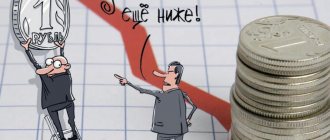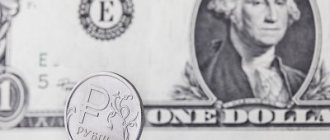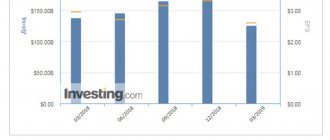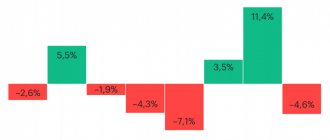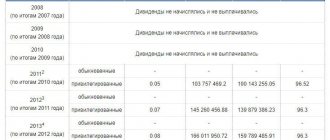Many people are now interested in the ruble exchange rate forecast for 2021. Will there be another depreciation? What will happen to the dollar in 2021? What will happen to the ruble? Is ruble devaluation possible in 2021? We all remember how the ruble has been in a fever since the fall of 2014. The rate on the board of exchange offices could change several times within an hour. The situation was close to panic. Is it possible to repeat? Let's try to figure it out. Currently, there are several main factors influencing the ruble exchange rate: the price of oil, the policy of the Central Bank of the Russian Federation, payments on external debt, and the geopolitical situation. There are also a number of smaller circumstances that contribute to the behavior of the ruble, but they also need to be taken into account. So, let's look at the key points that help us understand what awaits the ruble.
Why is everyone suddenly talking about denomination?
And where exactly did it all start?
Discussions about redenomination began after the head of information and analytical Alexander Razuvaev came up with the idea of redenominating the Russian currency a hundred times. According to him, this should strengthen confidence in the ruble .
Later, the leader of the LDPR party, Vladimir Zhirinovsky, spoke out in support of Razuvaev. The politician noted that after the redenomination, the money will be more understandable to citizens , and the value of the US dollar will drop to 65 kopecks .
The Central Bank and the Academy of Sciences spoke out categorically against this idea. The departments noted that the Russian economy does not need redenomination. Such a reform will only lead to spending on printing new banknotes and replacing old ones.
What course do economists predict?
- If, at the end of the sanctions deferment period at the end of the first quarter of 2021, a significant tightening of US sanctions follows, and oil prices remain at $65–70 per barrel, the average dollar exchange rate for 2021 will be in the range of 65–67 rubles. , says Anton Pokatovich. The optimistic scenario assumes an increase in oil prices to $75–78 and a strengthening of the ruble to 63.5–65.5 rubles .
- Raiffeisenbank's forecast for 2021 is about 70 rubles. per dollar, says Stanislav Murashov.
- “Our forecast for the end of 2021 is 65 rubles. paired with the dollar and 80 paired with the euro,” points out Tatyana Evdokimova.
- Analysts at American banks are more optimistic about the ruble: according to Bank of America Merrill Lynch, the dollar exchange rate in 2019 will average 62 rubles. Analysts at Morgan Stanley also predict 62 rubles. per dollar in the fourth quarter of 2021 (this implies an increase of 11% compared to the end of 2021). “High yields [on Russian government securities], Russia's good balance of payments and prudent monetary and fiscal policies should support the currency. At the same time, the tail risk of sanctions remains a constant threat to investors,” they wrote in a November 25 note.
What is denomination and devaluation of the ruble?
In simple words
Devaluation is the depreciation, “drawdown” of the state currency in relation to other currencies. The main reason for the devaluation is problems in the country's internal economy (there may be other factors).
Unlike devaluation, redenomination does not indicate any changes in the value of the currency. Denomination is the appointment of a new denomination . During denomination, the purchasing power of a currency relative to others does not change.
The denomination of the ruble is a cosmetic procedure that will not change the purchasing power of Russians. If you previously had a salary of 100,000 and you paid 50 rubles for bread, then when your salary turns into 10,000 rubles, bread will cost 5 rubles.
Anastasia Kosheleva
, editor-in-chief of Investing.com portal, Russia
In other words, denomination is a financial reform, during which zeros are “cut off” and, as a result, old bills are exchanged for new ones.
Why are the terms denomination and devaluation used together?
On the one hand, devaluation and currency redenomination are completely different concepts. The first reflects the consequences of problems in the economy, the second rather refers to a technical procedure, a “redesign” of banknotes, if you like. From the psychological side, these concepts are generally opposite, despite the fact that both words begin with the same particle:
Denomination is a psychological procedure that is the reverse of devaluation, although both words begin with the particle de. Devaluation is a decrease in the market price of the national currency in relation to foreign ones. The denomination or increase in the nominal value of new banknotes issued (“crossing out zeros”, as it has become popular among the people) is intended to convince the population that the authorities confidently control processes in the foreign exchange and money markets and are able to curb inflation.
Sergey Tolkachyom
, First Deputy Head of the Department of Macroeconomic Forecasting and Planning, Financial University under the Government of the Russian Federation
For example, after the 2021 redenomination was carried out in the Republic of Belarus, the exchange rate of the Belarusian ruble “strengthened” from 20,053 rubles (BYR) to just 2 rubles (BYN) per 1 US dollar:
This situation complements well the example given earlier by Anastasia Kosheleva about a loaf of bread. True, here, instead of bread, the value of the dollar has decreased significantly.
Now let's look at the other side - and yet, what do these concepts have in common?
Since the currency denomination in the Republic of Belarus took place relatively recently (in 2016, while in Russia - in 1998), an example of this monetary reform will most accurately reflect the relationship between the two terms.
The Belarusian denomination of 2021 was preceded by the denomination of 2000. Then (in 2000) 3 zeros . And one day the dollar began to cost 320 rubles, instead of 320,000 rubles.
The photo shows money from the 1994 model and a new one at that time.
Over the next 16 years, from 2000 to 2021, due to problems in the economy, the exchange rate of the Belarusian currency steadily declined against the dollar. The value of the dollar increased from 320 rubles on January 1, 2000 to 20,053 rubles on June 30, 2021. That is, the Belarusian ruble devalued by almost 6,500% percent:
The cost of 1 US dollar to the Belarusian ruble in dynamics. On January 1st of each year.
In the graph we see a clear example of currency devaluation over 16 years. At that time, the salary received was measured in millions (however, not all foreigners understood that 2 million rubles is only 100 US dollars). In order to somehow make it easier for the population and business to use cash, it was decided to remove 4 zeros.
Banknote 10,000 rubles, which was in circulation until 2021 and the equivalent modern 1 ruble
Thus, from the example we see that one concept is a consequence of another . We find that the denomination is a consequence of the devaluation of the ruble. It is for this reason that these words are very often found together.
Related materials
00:00 — December 25, 2017
We ourselves are not poor
Russia has again forgiven billions of debts.
What could you do with this money? The lowest level of inflation among analysts surveyed by Lenta.ru is expected in Gazprombank - 3.2-3.8 percent at the end of 2018. “Despite some weakening of the ruble, the growth of prices will be restrained by low economic growth rates. The greatest potential for accelerating inflation still remains in the field of services to the population, prices for which are largely determined by the dynamics of wages,” believes Maxim Petronevich.
Economist Alexander Isakov from VTB Capital predicts maximum inflation at the end of 2021: “The acceleration of inflation is due to the exhaustion of temporary factors, the low base effect, as well as increasing pro-inflationary pressure from consumer demand.” According to Isakov, inflation at the end of 2018 will accelerate to 5.1 percent.
Consensus forecast for inflation at the end of 2021: 4.15 percent.
In 2021, the main factor supporting the Russian currency will be the agreement to reduce OPEC+ oil production, which will last until the end of the year. The ruble exchange rate will also be supported by the new budget rule, according to which all additional oil and gas revenues will be sent to reserves (we are talking about all oil and gas revenues when the price of Urals oil is above $40 per barrel).
New sanctions from the United States, which will be announced in February, may have negative consequences for the Russian currency. According to the proposals of the American establishment, Russian bonds, as well as all individuals and legal entities that do business with Russian individuals and legal entities from the sanctions lists, may fall under them.
A little history of the denomination in Russia and the USSR
As is known, in the 21st century, not a single denomination of the ruble was carried out in Russia. At the same time, during the 20th century, 6 monetary reforms were carried out on the territory of the USSR and Russia (after the collapse of the USSR). Let's look briefly at each.
Reform 1922-1924
The very first denomination (or rather, there were 3 of them over these years) was carried out in the period from 1922 to 1924. Against the background of the civil war and unsuccessful policies, there was a strong depreciation of money. During the reform, first 4 zeros were cut off, and a year later 2 more were removed. A year later, in 1924, there was another denomination, then money was exchanged 1 to 50,000. As a result of the reforms carried out in these years, chervonets and Soviet rubles.
Reform of 1947
The next reform took place in 1947, when the currency was denominated 10 times. By the way, for small amounts, money was exchanged at a one-to-one rate. For those who had large sums of money, odds reached 1 to 3, 1 to 2 or even 1 to 10.
Of course, these two post-war reforms were very necessary for the country. The economy got rid of excess money supply and counterfeits.
Post-war reforms (after the Civil War and the Great Patriotic War) were, of course, successful and useful. The economy got rid of excess money supply, counterfeit money, and the purchasing power of the population increased.
Vladimir Maslennikov
, Vice President of QBF
1961 reform
The next denomination of the ruble occurred in 1961. , only 1 zero was removed . The true reasons are not yet known , since the lion's share of documents from that time are still classified, although big economic problems were certainly present at that time. The official goal of the reform was: “Simplifying the use of money by the population.”
And indeed, the physical size of money has become smaller, printing it has become cheaper, but for some reason the dollar has become twice as expensive . That is, if earlier 1 dollar cost 4 rubles, then after the reform, it already costs 90 kopecks, although in theory it should have cost only 40 kopecks.
Here we see a very interesting situation. Above we concluded that denomination is a consequence of devaluation. In this situation it was the other way around. Denomination became a possible reason for the devaluation.
In 1961, against the backdrop of a seemingly ordinary denomination and exchange of banknotes, the dollar to ruble exchange rate changed significantly. Goods and luxury goods that were associated with imports gradually became more expensive. There was a shortage of consumer goods. As a result of this reform, the welfare of the population as a whole decreased.
Vladimir Maslennikov
, Vice President of QBF
1991 reform
This was followed, in the still USSR, by the monetary reform of 1991 . direct cutting of zeros then . There was an exchange of banknotes of 61 for banknotes of 91. It was an unsuccessful reform, which took place in an extremely short time frame and in conditions of chaos. Experts say the main reasons for this reform are the fight against excess money supply and shortages of goods.
The 1991 reform took place over several days, during which there was chaos. People had to change money under severe restrictions. The actions of the authorities led to the fact that a huge number of old banknotes remained in hand and could no longer affect the economy. As a result, the country took the path of chaos, and inflation increased. All this did nothing to improve the economy.
Vladimir Maslennikov
, Vice President of QBF
1993 reform
The 1993 reform took place against the backdrop of the collapse of the USSR . The main reason for this reform was the fight against inflation and the withdrawal of old Soviet money of the 61-92 model . There was no denomination then either. Money was exchanged one to one . Cash exchange at that time again took place in conditions of chaos, panic and restrictions. As a result, many people simply did not physically have time or were unable to exchange their money for new ones. As a result of this, millions of citizens lost their savings.
In 1993, the exchange of money was caused by the collapse of the USSR and the release of a new national currency. The results are an even greater erosion of trust in the authorities, the withdrawal from circulation of that amount of money that has not become particularly significant for improving the economy.
Vladimir Maslennikov
, Vice President of QBF
1998 reform
Finally, the final reform of 1998 . By the end of 1997, the dollar was worth 5,960 rubles , while in 1993 its value was 417 rubles . This reform proceeded quite smoothly and was completed only in 2002 . It was accompanied by a denomination of 1000 times, that is, 1000 old rubles corresponded to 1 new one. It was then that our modern money appeared.
The 1998 reform was the final one in the 20th century and was the mildest compared to all previous ones. If we do not take into account the subsequent default of 1998, the results of the denomination itself were satisfactory.
Vladimir Maslennikov
, Vice President of QBF
Thus, we see that out of 6 monetary reforms that were carried out in the 20th century, 4 of them were accompanied by denomination. There were clear reasons for each denomination - from eliminating the post-war consequences to the fight against excess money supply and counterfeit bills.
History shows that often the implementation of any economic reforms, unfortunately, has a painful impact on the well-being of citizens. Therefore, they should be carried out only if there are clear grounds for it.
Related materials
00:04 — December 28, 2017
Chronicles of Madness
Within a year, Bitcoin has turned the world upside down.
And then it collapsed. The Bitcoin exchange rate in 2021 may be supported by the presence of a large amount of free money, says Yaroslav Kabakov, Deputy General Director of Finam Investment Company. “There is free money in the markets - since the beginning of 2021, the Dow Jones index has grown by 24 percent. The reduction of taxes on the wealthy part of the population by Donald Trump will bring freed up funds to the stock exchanges. Of course, in an effort to show returns above the market average, some investment portfolio managers will try to play on the Bitcoin price - this is one of the important reserves for future growth,” the analyst said, predicting that by the end of 2021 Bitcoin will cost $18,850.
Gazprombank representative Maxim Petronevich believes that the rate of the main cryptocurrency will be from 2 thousand to 50 thousand dollars. For the minimum threshold, he takes the cost of operating and capital costs (electricity costs plus equipment), which in 2018 will be at the level of two thousand dollars.
Consensus forecast for the Bitcoin price at the end of 2021: $26,837 per Bitcoin. However, this forecast is based on the opinion of less than half of the analysts surveyed by Lenta.ru.
So will there be a denomination in 2021 or 2021?
Let's try to operate not with what once was, but with what we have now. Let's consider the likelihood of a denomination from the point of view of its prerequisites.
Hyperinflation
One of the main prerequisites for carrying out a redenomination may be an increase in inflation by thousands of percent per year . TradingView platform development director Vitaly Kirpichev argues that at the moment redenomination is a completely unrealistic scenario, since inflation in Russia is currently hovering around 4 percent.
Denomination in Russia is a completely unrealistic scenario for the coming years. There's simply no need for it. This solution is applicable when inflation in a country reaches hundreds of percent per year. In this case, for the convenience of cash payments, bills with a denomination of 1000 rubles are replaced. for coins with a denomination of 1 rub. Taking into account the fact that inflation in Russia now fluctuates around 4%, the existing denomination of banknotes and coins is quite convenient for cash payments and does not require changes.
Vitaly Kirpichev
, Director of Platform Development at TradingView
Stimulating economic development
Valeria Minchichova , an associate professor at the Financial University under the Government of the Russian Federation , cites stimulation of domestic producers as one of the motives for carrying out the denomination. After denomination, all prices are rounded up, as a rule, and the foreign exchange rate also increases.
To confirm the expert’s words, one can recall the reviews of many citizens of Belarus. People complained that after the Belarusian denomination of 2021, prices on store shelves increased precisely as a result of such roundings.
As Valeria Minchichova , carrying out a denomination to achieve these goals is a very dubious decision, since the ruble is already under severe pressure in the context of tense world politics and low oil prices. There is clearly no point in creating new preconditions to reduce it. Sanctions in themselves already provide an incentive to develop domestic production of goods and services. Intentionally exposing the ruble to an even greater risk of depreciation is an additional risk.
... But such stimulation of domestic production is already happening due to sanctions imposed against Russia and retaliatory measures since 2014. A number of goods have become unavailable, others are very expensive and of different quality. Again, the reason for the denomination has not yet been identified.
Valeria Minchichova
, Associate Professor, Department of World Economy and International Business, Financial University under the Government of the Russian Federation
Fighting the gray market
Russian economist and financier Nikolai Neplyuev cites as an argument the fact that denomination can partly help in the fight against the shadow economy, gray transaction schemes, and salaries in envelopes.
How does denomination help in the fight against illegal cash trafficking? In the process of denomination, old money is exchanged for new money. If a person or company has undeclared funds, then they will not be able to exchange them.
However, as the expert himself claims , it is necessary to fight not with the effect, but with the cause. If the denomination will reduce the gray market, it will not be much and not for long.
You need to fight not the effect, but the cause, otherwise it is only a temporary and ineffective effect. And in order to reduce the shadow economy within the state, it is necessary to reduce the load on the labor market.
It is advisable to objectively look at the general economic situation in the world and the country, and it indicates that many representatives of small and medium-sized businesses are close to default and are simply unable to meet their tax obligations. Many are burdened with loans and are unable to run a profitable business in the current situation, especially on the eve of the second wave of the pandemic.
Nikolay Neplyuev
, Russian economist, financier
Simplifying calculations
Simplification of calculations is also cited as one of the reasons for denomination . If an average worker needs a suitcase or a diploma to receive a salary, this creates certain household and technical inconveniences.
However, at the moment there is no such situation in Russia . To receive a salary of 40,000 rubles , you will need only 8 bills of 5,000 each .
Sergei Tolkachev noted that, in principle, today this cannot be a problem, since in the era of electronic payments there is, in principle, no need to carry a wallet with cash.
What do we have now in Russia? There is no problem of an abundance of bills of different denominations. Moreover, cash payments are steadily declining in favor of bank cards and electronic payment systems.
Sergei Tolkachev
, First Deputy Head of the Department of Macroeconomic Forecasting and Planning, Financial University
Availability of large amounts of cash in the economy
the Central Bank itself admits that we now have a huge amount of money in circulation . A larger money supply provides more opportunities for the black and gray economy to flourish. And without combating the reasons for the emergence of illegal schemes, denomination will only be a very expensive, but useless procedure.
On the other hand, Valeria Minchichova, associate professor at the Financial University under the Government of the Russian Federation, noted that a large amount of cash in some cases can even contribute to economic growth. In addition, the increase in cash in circulation occurred due to the period of self-isolation - people withdrew cash primarily due to negative expectations and not at all in order to finance the shadow sector.
However, as a rule, when the amount of cash in the economy increases, rapid economic growth is also recorded. But it should be taken into account that the increase in the volume of cash in the Russian economy in 2021 occurred against the backdrop of a pandemic and mandatory self-isolation. That is, cash is withdrawn not to finance the shadow sector, but primarily due to negative consumer expectations. So, in its pure form, the reasons for the denomination are again not visible.
Valeria Minchichova
, Associate Professor, Department of World Economy and International Business, Financial University under the Government of the Russian Federation
Weakening of the ruble
The ruble is weakening today, and this really does not cause much optimism, but the reasons for the decline are quite understandable . Events in Belarus and the story with Alexei Navalny again raised the topic of anti-Russian sanctions among Western officials. So far, all these events continue to put pressure on the domestic currency.
However, 75 or even 80 rubles per dollar is far from the 6,000 rubles it cost at the end of 1997. Thus, only a devaluation of 500-1000%, which does not exist now, can lead to denomination.
Thus, only a significant devaluation can lead to denomination, the level of which today is not critical and necessary for such a reform.
Vladimir Maslennikov
, Vice President of QBF
Are payments safe?
The Central Bank is considering three options for issuing a digital ruble - using the technology of a decentralized distributed registry (blockchain), a centralized registry or a hybrid type, it follows from the report. A centralized registry is more productive, but less resistant to various types of incidents compared to a decentralized one. The choice of platform will also influence information security methods.
“From an information security point of view, digital currency or network means of payment, subject to simple rules of digital hygiene, are safer than any classical currency,” says Group-IB CEO Ilya Sachkov. In general, the same attack scenarios are relevant for the digital ruble (if it is issued using blockchain technology) as for other cryptocurrencies, adds Sergei Nikitin, deputy head of the Group-IB computer forensics laboratory. These are banking Trojans, phishing, fraud, re-issuance of SIM cards, theft of crypto keys, etc.
“The technologies that are used to create and circulate digital currency have already been quite well studied and are quite safe,” says Sergei Golovanov, leading expert at Kaspersky Lab. The emergence of a digital ruble is a logical step for the financial sector, he concludes.
Let's sum it up
To summarize all of the above, the only real prerequisites for redenomination can be a weakening of the ruble and a large money supply in the economy . But as we found out, denomination will not reduce criminal payment schemes. Since all owners of gray schemes will transfer their capital into foreign currency, cryptocurrency, futures, and withdraw money to offshore companies. Ordinary citizens will suffer first of all , since denomination will lead to rounding of prices, and we like to round up prices.
The growth of the dollar also cannot be the reason for the denomination . Carrying out a denomination is a very expensive undertaking for the budget, and of course it will fall on the shoulders of ordinary hard workers.
In the end, what result will we achieve?? Let's say they cut off 1 zero and a dollar will cost 8 rubles instead of 80. Will this lead to an increase in wages? - of course not . Of course, the government probably knows these simple truths and the near future will pass without serious economic shocks for us.
How often are new banknotes and coins introduced?
Depending on how exactly the state introduces new money into circulation, the number of such attempts also depends. If this is a complete change of currency, then there is no point in talking about systemic behavior. It all depends on the economic situation and necessity. However, once every year or two, new coins and banknotes are introduced to replace the old and worn ones.
A more advanced system of protection against counterfeiters is emerging, and banknotes are being gradually replaced. The press received an announcement that we should expect the release of new banknotes. The first of which will be two hundred rubles and two thousand. Modernization will provide more reliable protection; as a rule, this must be done once every 5-7 years. But the Russian ruble may completely change its appearance.

